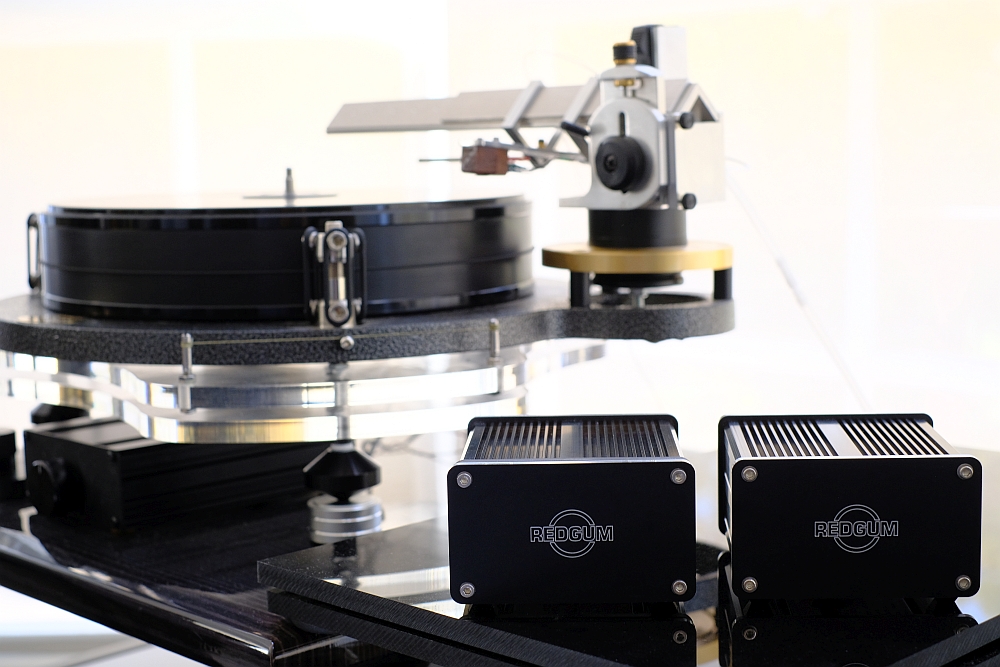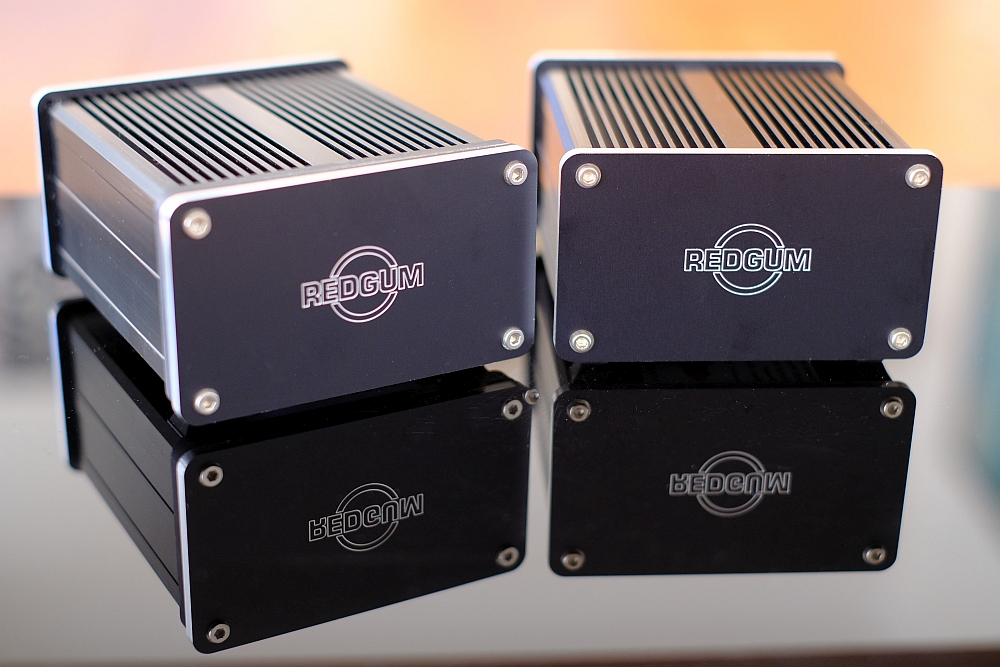REDGUM Audio’s Ian Robinson (Chief Designer) and Lindy Gerber (Marketing and Administration) run this uniquely ‘Aussie’ manufacturing concern and the team rate among the most dynamic, and nicest, duos in our local high-end industry. The company’s website, product instruction manuals and the nomenclature of the wide variety of product offerings also reflect the laconically quirky “larrikin” humour Australians are renowned for. But be reassured here and now that, while appreciating the lighter side of life, both Gerber and Robinson have their feet firmly planted on solid ground – REDGUM Audio designs are the fruit of astute design and concrete engineering principles.
The adherence to strict yet as-simple-as-need-be engineering methods is illustrated succinctly in REDGUM Audio’s top phono stage, the RGPH2ENR, part of the made in Australia ‘Amplifolia’ Signature Series. This diminutive two box design features firm observance to RIAA (Recording Industry Association of America) principles, the industry standard established in the mid-1950s to universalise vinyl playback equalisation in order to correct for flat frequency response.
The two boxes are constructed from anodised aluminium, are well-built and feature a company logo etched on the face plates. While one box features the phono stages electronics and dip-switches for the various MM/MC and gain settings, the second component houses the ‘Ultra-Low Noise’ linear power supply. The two connect via a well-made 4-pin low voltage cable. Power confirmation is via a red LED embedded within the on/off rocker switch at the rear of the power supply unit and by red and green LEDs on the main unit’s rear panel.

RCA socketry is of high quality USA-made gold plated types and there’s a wing nut post for the ground cable. REDGUM Audio includes a good Oxygen-Free Copper (OFC) RGAP05 interconnect cable with the phono stage. As simple as the units are, they reflect good assembly and a feel of austere quality. Having said that, the two boxes are very light in terms of weight so if you have garden hose-style interconnect and AC cables, you’ll need to anchor or weigh down these babies.
The main phono stage unit features a rubber ‘stopper’, or plug, on its bottom plate. Removing the plug reveals a bank of four dip switches which can be configured to accept MM and MC cartridges while referring to the owner’s manual will enlighten you on the variety of dip switch configurations adjustable for differing cartridge gains and impedances. The RGPH2ENR comes configured from the factory for MM cartridges. REDGUM Audio suggests leaving the units powered at all times (a six watts load) for best results. As mentioned above, REDGUM Audio states that the RGPH2ENR follows the standard RIAA curve to within a ¼dB “from end to end”. That in itself is a flat frequency response target achieved, right there. According to Ian Robinson:
As a consequence of this, you will hear something quite interesting! Normally, the typical surface noise "pops" and crackles of vinyl form a distracting barrier between you and the music. A layer, all the more intrusive to our sensitive "spoiled-rotten-by-CD” ears!
In contrast, what the REDGUM Audio Phono Preamp does is, somehow, distance the listener from that layer such that the noises remain anchored "around" the speakers but disappear as a focus. In other words, the noise on the disc surface just does not distract in the old way! What remains for your enjoyment is the full soundstage of just the music. Old vinyl records regain their magic! A return to really "clean" levels of vinyl reality.
REDGUM Audio prides itself on its products’ low levels of hum and noise. The RGPH2ENR is said to possess a noise floor over 20dB below the surface noise of the “best vinyl discs tested”. As is typical of REDGUM Audio, the owner’s manual not only features humour (we liked the “an apparent product ‘death’ will result” sentence referring to incorrect power adaptor plug-in for the single-box version RGPH2) but also a whole lot of useful information including solid advice on speaker positioning and room optimisation. Kudos!

On a technical note, Ian Robinson explained the following regarding noise levels and the concepts behind the power supply design:
As you may be aware, phono stages are very sensitive, and so are very prone to pick up EMI noise and hum fields. Bearing this in mind, the REDGUM RGPH2ENR has a totally separate power supply housed in a Faraday cage that can be separately placed up to 2 meters away from the phono stage inputs. This power supply uses a specially-designed EI-style transformer manufactured expressly by Kingwall in Hong Kong to REDGUM specifications and used only for the RGPH2ENR. The mains power is supplied by a standard IEC 3-pin power lead to an EMI-filtered IEC socket in the power supply case. The power supply cage is earthed directly to the mains supply, and internally there is switching for 120/240volts (with automatic resetting overload protection if the voltage is wrongly adjusted).
The secondary supply earthing is totally isolated from the mains supply and uses the connected turntable earthing system as reference point. The dual supply lines are decoupled, double regulated and then transmitted through a special shielded cable using gold-plated mini-balanced line connectors to the phono stage (which is also housed in a Faraday cage) where they (the dual supply lines) are decoupled a second time.
And finally, throughout the power supply and phono stage, special attention is applied to supplying high speed, high current transients and very stable earth paths.
The RGPH2ENR is capable of accepting 47 kohms and 47 ohms input impedance for MM and MC cartridges respectively with a source impedance of 100 ohms. Other load impedances can be matched to your preferred cartridge on request. Sensitivity is 5 mV for MM and 0.5 mV for MC with quoted gains of 35dB and 61dB respectively. Stated input voltages are 0.01 mV minimum for MC with a maximum of 700 mV for MM. As referenced above, the RGPH2ENR strictly follows the RIAA standard with a frequency response from 10Hz to 35kHz +/- 0.5dB. Channel separation is a healthy 60dB while the signal-to-noise ratio (SNR) is over 90dB.
Give it a Whirl
I placed the two boxes on the top shelf of the superb SGR Signature Rack just behind the Michell Engineering Orbe (a recipient of the full Gert Pedersen modifications). The two RGPH2ENR units are fairly light in terms of weight so careful positioning is required when using heavy gauge cables. The sILENzIO (review coming soon) cables I’m using are quite stiff and heavy so I ended up having to anchor down the main phono stage box with a top weight. The thin silver cables channelling directly from my Trans-Fi linear air-bearing arm plugged directly into the phono stage.
At this stage I should mentioned that, as Ian Robinson promised, the engineering mindfulness paid to the ground scheme and the noise reduction techniques adopted on to the RGPH2ENR have resulted in a component that is totally and profoundly… silent. Not a peep, hum or buzz to hear; neither from the unit itself or through the system on to the speakers.

This silence carried through to the sonics when playing music. There’s a very quiet background reminiscent of CD playback – vinyl surface quality permitting, of course. And while you may notice that at some stage pretty soon after having the RGPH2ENR in the system, the things that you will notice straight away are the music’s dynamism, the overall neutrality, great detail retrieval and the state-of-the-art bass quality. Before detailing other characteristics of this phono stage’s presentation I’ll deal with these most outstanding aspects.
The most obvious quality upon playing your first record will be the superb bass reproduction. This has always been a trademark – or ‘house sound’ signature – of REDGUM Audio products and it’s on full display via the RGPH2ENR. I’m talking bass quality reminiscent of the best digital can offer. Bass guitars and low cello notes have extraordinary resolution, attack and depth. It’s a palpable, rhythmically propulsive bass that gets the toes a-tappin’. Sure, the Michell’s modifications are renowned for achieving improved bass registers over the standard model but, here, the little two-box phono enhanced even that acknowledged excellence.
This rhythmic musicality ties in with the RGPH2ENR’s outstanding dynamic expression where the swings between low-lows and ultra-crescendos scale massiveness. Dire Straits’ almost clichéd demo track “Private Investigations” has that famous passage around the middle of the track. It’s a dark carpark… the footsteps… the cat… the broken glass, and then, the outburst of the drums. The vinyl-playing package of ‘table, tonearm, cartridge and, at the chain’s end, the RGPH2ENR makes for scary explosive stuff.

The dynamic contrast capabilities don’t overshadow the ability to extract fine detail retrieval in the splintering glass or the cat’s night miaou. It’s all there presented clearly and unforced. Spinning The Pixies’ Alt-Rock classic Doolittle had a pin-to-the-wall quality that was addictive in terms of raw power and bass slam. You’ll have great fun with The Beatles’ “Come Together” from Abbey Road (a new 180g pressing purchased recently) where the multitude of bass hits (kick drum, etc.) punch hard and dip low.
Of course, one of analogue’s great strengths is in the natural midrange where many aficionados claim digital can often sound somewhat glary or congested in comparison. The best illustration comes from great male and female voices. On hand on vinyl I had the pleasure of spinning Kim Gordon, Grace Jones, Nick Cave, Black Francis (AKA Frank Black), Jim Morrison, Mark Knopfler and many more excellent vocalists. All sounded present and tonally accurate while also resolving subtle vocal techniques and tonal fluctuations. Francis Black’s manic torment-ridden scream as he describes the tragedy of a mother’s loss, cuts through the mix to pull at the heart strings. Similar attention to finer detail and delicately-presented high frequency information is apparent throughout the Prog-Rock Pink Floyd masterpiece that is The Dark Side Of The Moon where the special effects intros on “Money”, “Time” and other tracks are fully resolved. As an aside, experiencing Roger Waters’ Us & Them live performance in Sydney recently shone a new light on these absolutely classic songs. To say that his concert was sensory overload and truly magnificent are understatements.

Well-produced acoustic recordings, such as Gold Note’s beautifully-captured Limited Edition Carillon (my number 403 from 500 prints edited from the original master tapes) by Italy’s Ensemble Operarmonica sound immersive and true-to-tone with delicate flute detail and textures and great extension on the organ’s low notes.
The expansive soundscapes of Tangerine Dream’s Underwater Sunlight (Teldec Direct Metal Mastering) are huge in width and depth with the electronica orchestrations producing a dreamy serenity that draws you into the music… provided all is in order with respect to the preceding mechanical elements, the RGPH2ENR will faithfully recreate whatever music you feed it.
Conclusion
What should you ask of a high quality phono stage? In my view, a well-engineered phono should provide adequate gain from the groove-on-to-cartridge-on-to-tonearm pick-up, interpolate the signal from input through to the output stage and on to the amplification device – all requiring the delicate signal to progress unscathed and colouration-free. In addition, it should provide appropriate gain, impedance and cartridge type (MM/MC) options. While the REDGUM Audio RGPH2ENR excels at all of the above requisites, at the asking price it also presents an exceptional value for money proposition. Screaming bargain actually…
REDGUM Audio states in its product brochures that once the ‘REDGUM’ sound is heard, it cannot be unheard… I for one, am so glad I’ve heard it, and will not even attempt to un-hear it… I’m confident that your ears will concur. This baby stays solidly embedded within the context of my reference system. Bonza!
… Edgar Kramer
This email address is being protected from spambots. You need JavaScript enabled to view it.
Associated Equipment
- Speakers — Wilson Audio Alexia Series 2, Axis Loudspeakers VoiceBox S (nearfield monitor)
- Amplifier — Gryphon Audio Antileon EVO, Gryphon Audio Diablo 120 (in for review)
- Preamplifier — Supratek DHT Reference, Lightspeed Attenuator LDR passive
- Sources — Digital: Yamaha CD-S2100 used as transport, Totaldac d1-core DAC, MacBook with BitPerfect software, AIFF files. Analogue: Michell Engineering Orbe with Gert Pedersen Level 3 modifications and Origin Live Ultra upgraded motor, Trans-Fi Terminator air bearing linear-tracking arm, Grado Reference cartridge, REDGUM Audio RGPH2ENR phono stage
- Processor — DEQX PreMate
- Cables — sILENzIO loom, Vermouth Audio Black Pearl Mk.II loom
- Audio Rack – SGR Audio Signature
REDGUM Audio RGPH2ENR Phono Stage
Price: AU$1190
Warranty: Seven Years
Australian Distributor: REDGUM Audio
+61 3 9001-6788
www.redgumaudio.com
REDGUM Audio
401 Belgrave – Gembrook Road
Emerald 3782, VIC, Australia
+61 3 9001-6788
www.redgumaudio.com











